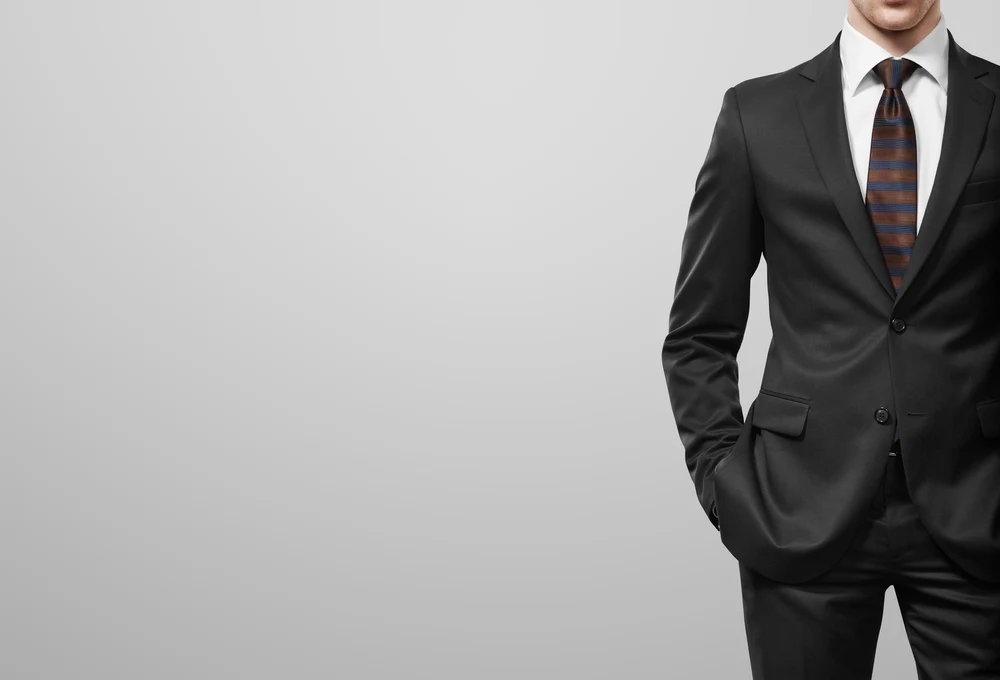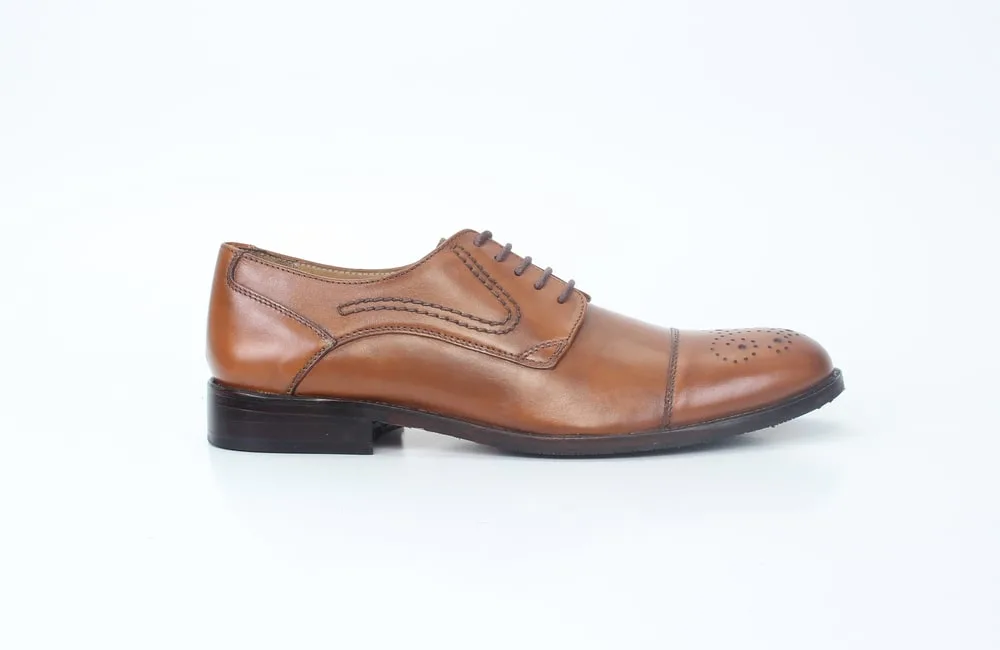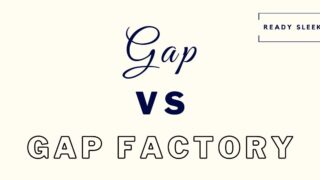Pairing dress shoes and suits may not sound complicated, but there’s plenty that can go wrong. The main reason is often combining the wrong pair with the wrong suit. So, can you wear derby shoes with a suit?
Derby shoes can be worn with suits. Formal suits will look better with dark brown or black Derby shoes with no brogue patterns. More casual-looking suits can be worn with lighter-colored Derby shoes and minimal brogue decoration, but it’s still usually best to avoid suede.
Although that’s the gist, there’s a lot more to it.
The key is matching the formality of the suit with that of the Derby shoes.
Let’s dig deeper.
Derby Shoes And Suits: An Introduction
Derby shoes are dress shoes with two large quarters containing the shoelace eyelets sewn onto the sides. The quarters are sewn on top of the vamp to create a flap-like open lacing system.
Here’s a typical, more formal-looking pair on Amazon as an example:

Derby shoes come in a wide range of styles – mainly varying in terms of color, material, and patterns. But they will all have the same basic construction.
They are generally seen as being a notch less formal than the Oxford shoe with its sleek closed lacing system.
While Oxford shoes are seen as the go-to dress shoe to be worn with business suits, a relatively formal-looking Derby shoe is usually still very appropriate.
In fact, many people prefer wearing Derby shoes with their business suits, simply because they find the closed lacing system of Oxford shoes too tight. Derby shoes are a popular choice among people with wider feet.
A “suit” should be defined as a matching pair of pants and a jacket produced from the same roll of fabric.
Suits vary hugely in terms of color, fabric, and structure. But the pants and jacket should match for it to technically be labeled a suit (spezzato style excluded).
As I’ll discuss in more detail later on, suits, just like Derby shoes, can be considered “casual” or “formal” depending on specific features.
When combining Derby shoes and suits, the key to getting it right is to ensure that the formality levels sync well.
In other words, when wearing a more “formal” looking suit – go for a more “formal” looking pair of Derby shoes.
When wearing a more “casual” looking suit, you could get away with wearing a more “casual” pair of Derby shoes – to an extent.
Let’s discuss the specifics of pairing them in the right way.
How To Wear Derby Shoes With Suits (6 Tips)
Here are six tips to ensure you sync Derby shoes and suits in the best way possible.
1. Ensure It’s Appropriate
This is probably the most crucial step. There will be instances where a pair of Derby shoes simply won’t be a good choice for the specific suit you’re wearing or the event you’re attending.
In general, if the setting you’re attending is very formal, a pair of Oxford shoes would definitely be better than Derby shoes.
This may include more formal work settings, interviews, and definitely black-tie.
While Derby shoes are absolutely fine to wear with chinos and jeans, with suits – you need to be a little more careful.
It’s easy to wear Derby shoes with the more casual-looking suits.
It’s also very reasonable to wear Derby shoes with more formal-looking suits, as long as the setting you’re attending isn’t very formal.
Semi-formal settings like more modern business offices and weddings are usually fine.
2. Match The Formality
Matching Derby shoes and suits in terms of formality is only possible when you know what features make some suits look more “casual” while some look more “formal”.
Casual Suit Features:
- Lighter shades/colors
- More patterns
- Inner leg seam details may be more visible
- The shoulders are less padded and more natural-looking
- Less “shiny” fabrics, such as linen, tweed, flannel, or cotton. They generally wrinkle more easily
- The jacket lining is less structured and feels lighter
- The jacket is more likely to have patch or flapped pockets.

Image From Deposit Photos
Formal Suit Features:
- Colors are generally darker
- Fewer patterns. Solid colors are more common.
- The jackets are more structured with padded shoulders and heavier lining
- Fabric is usually wool. Worsted wool is a common one as it has a noticeable sheen to it and doesn’t wrinkle easily
- Pockets are jetted or flapped, not patch.
- The pant legs will usually have a sharp center crease
- Peaked lapels and shawl lapels are more formal than notch lapels, but in reality you could find any of them in a formal suit.

Image From Deposit Photos
Being able to spot the difference between a more casual suit and a more formal suit is the first step when deciding what style of Derby shoes would be appropriate.
The next few tips will focus on choosing the right pair of Derby shoes based on the formality of the suit
3. Choose The Right Color
The color of your Derby shoes is so important when wearing a suit.
To keep things as simple as possible, when wearing a formal business suit that you feel doesn’t necessarily require a pair of Oxford shoes, go for a dark pair of Derby shoes.
Black or dark brown should be your go-to colors for Derby shoes being worn with formal business-professional suits.

Image From Deposit Photo
Anything lighter runs the risk of looking too casual. In general, the darker the shoes, the more formal they look. Derby shoes are no exception.
When wearing Derby shoes with more casual suits, you have a bit more freedom to experiment with color.
However, it’s usually best not to go too wild with it unless you’re intentionally looking to make a statement.
Lighter shades of brown such as tan brown are a good option for Derby shoes worn with casual suits, simply because they’re so versatile.

Image From Deposit Photos
They could comfortably be worn with chinos, jeans, and casual suits. They’d essentially become a workhorse of your wardrobe – a must-have.
While it’s possible to go with other colors for your Derby shoes when you’re wearing a casual suit, try at the very least to stick to neutral colors. Avoid anything too bright/bold, even when wearing a casual suit.
To sum that up, with a more formal suit – go for a dark brown or black pair of Derbys.
With a more casual suit – you’ve got more options, but don’t stray too far. At the end of the day, even a “casual” suit should be considered formal, at least to a certain extent. They will never be as casual as a chinos or jeans combination.
4. Avoid Suede
When wearing a suit, whether it’s more casual-looking or more formal-looking, it’s generally best to stick to calfskin or cowhide leather, as opposed to suede.
It’s pretty easy to find suede Derby shoes – they’re extremely popular and a great choice when you’re wearing chinos and jeans.
But the napped, rugged texture of suede is simply too casual to be worn with a suit.
Even a dark pair of suede Derby shoes will instantly give off a casual impression, simply due to the texture.
That’s why it’s a better option to always go for the “shinier” and more formal-looking types of leather like calfskin or cowhide.
They just combine a lot less awkwardly with suits than suede or other, more rugged fabrics do.
5. Careful With Brogue Patterns
“Brogue” shoes are simply dress shoes that have decorative perforations (i.e tiny holes) on the upper.
Any style of dress shoe could technically be “brogue”, but these perforations are usually found on Oxford and Derby shoes.
Quarter brogue Derby shoes have a straight toe cap with perforations lining the edge of the toe cap alone.
Semi brogue Derby shoes will also have a straight toe cap with perforations lining the edge, but will also usually have a “medallion”. A medallion is a fancy pattern of perforations on the toe cap itself.
Full brogue (a.k.a wingtip) Derby shoes have a pointed toe cap with a typical “W” shape. The brogue perforations line the edge of this W-shaped toe cap, as well as the borders of the quarters along the sides.

Image From Deposit Photos
As you can imagine, the more brogue-ing you’ve got, the more casual the Derby shoes will look.
In general, avoid brogue Derby shoes altogether when you’re wearing a more formal-looking suit.
Even when wearing a more casual-looking suit, it’s a good idea to not go further than semi-brogues.
Having the decorative pattern along the horizontal edge will be eye-catching and produce a nice aesthetic. A medallion with a semi-brogue may be appropriate for a very casual-looking suit.
But wingtips will rarely ever look good when wearing any form of a suit – they’re simply too casual. Save them for your chinos and jeans combinations instead.
6. Avoid Spectators
“Spectators” are shoes with two contrasting colors. Usually, the heel cap and the toe cap are one color, while the main body of the shoe is a completely different color. Spectator Derby shoes aren’t hard to find.
They’re just as attention-grabbing and eye-catching as you’d imagine. But it’s a very casual appearance and should never be worn with formal attire.
When wearing a formal suit, stick to a single, dark color for your Derby shoes.
Even when wearing a casual-looking suit, it’s usually best to avoid spectators, simply because of how casual they usually come across.
It’s great to own a pair of spectators because of how fun they are. They work great in casual and smart-casual outfits – for example, with chinos or jeans.
But in general, keep them away from suits. It’s simply not worth the risk.
Conclusion
There you have it.
Hopefully, everything you could possibly want to know about wearing Derby shoes and suits in the most effective way possible.
It isn’t complicated, but as you can see, a bit of knowledge is essential if you want to do it the right way.
Enjoy.
Ready Sleek founder. Obsessed with casual style and the minimalist approach to building a highly functional wardrobe. Also a fan of classic, vintage hairstyles.







